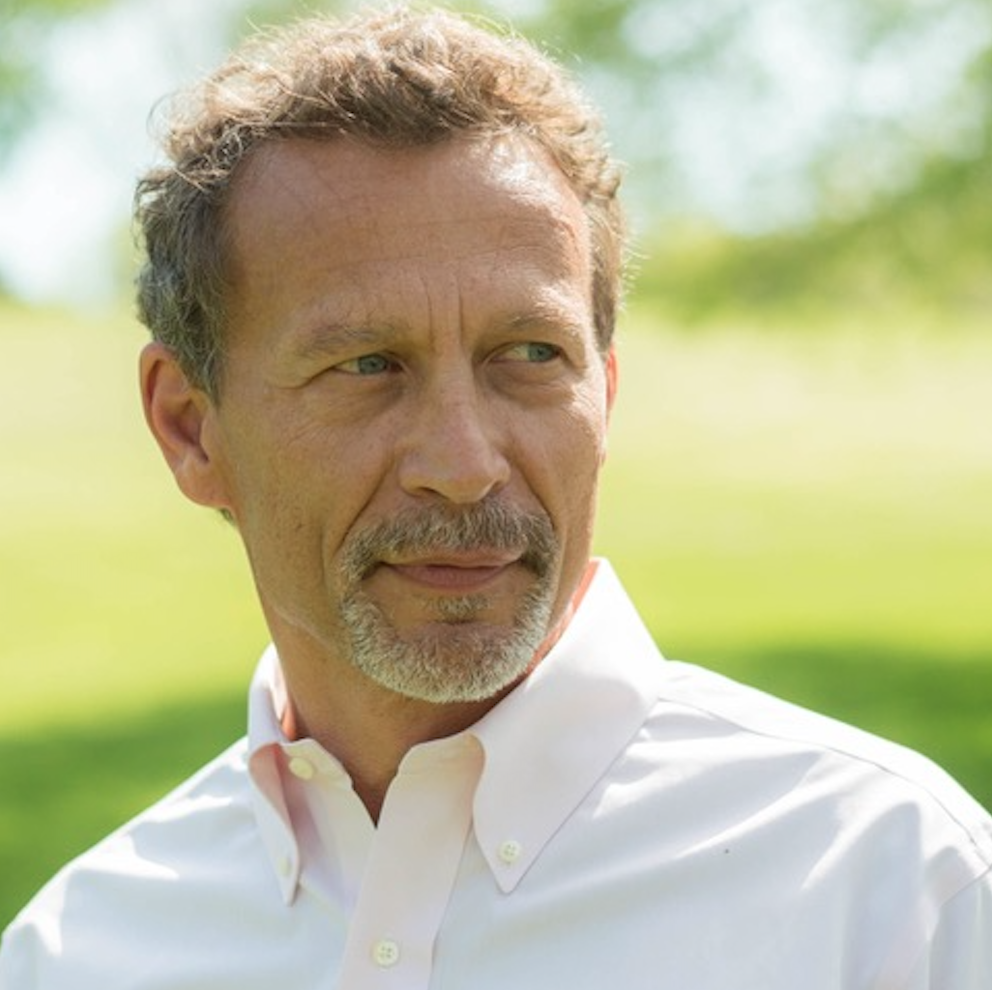What is Sensemaking?
by Albert Linderman, Ph.D.
Leaders of organizations are in what Yuval Noah Harari (21 Lessons for the 21st Century, 2018) describes as a double bind. If they only listen to what is around them they will lose touch with the average person. If they spend too much time in the margins (where a lot of insight and innovations emerge, but also a lot of bunk) they will waste time. One of the promises of the focus of this article, sense-making methodologies and ethnography, have the potential, with the right tools to bridge this gap.
Let’s start with a look at a human phenomenon. Think back over your day. Action, judgment, choosing, potential, mystery, fear, inference– all are typical parts of our daily experience as we encounter situations at work or in our personal lives. The kinds of thoughts we have–What should I do next? How does how I see myself affect the choice I am considering? What are my feelings about this situation? What am I hoping for as an outcome? These thoughts are the essence of what has been called sense-making. Everyone “makes sense” and we are doing it all the time in our work life and in our personal life.

Individuals have patterns of making sense. As well, groups of people, such as a work team, or people in search of social services in a given community, may have similar patterns to one another in making sense. Increasingly, businesses, governments, and communities employ the related crafts of ethnography and sense-making methodologies to help them understand how people make sense of their contexts. Applications include seeking to understand their customers, staff, leaders, residents, and others in order to improve service, get new ideas, design new products, and the like.
I am a cultural anthropologist who has used ethnography and sense-making over the past 3 decades in numerous settings (government, corporations, communities, nonprofits) and have found ethnography and sensemaking approaches congruent with one another and highly useful in change management, product development, and culture building in communities and organizations. In this white paper I provide an orientation to summarize these two fields, how they are related and how they are being used. I give particular attention to sense-making as there are varied approaches.1
Ethnography
Ethnography is drawn from cultural anthropology and in use since at least the early 1900s. Ethnographs describe a society from within people’s natural environment by using observation, participant-observation, and interviewing. This was primarily used in academia until the past couple of decades when an understanding of what constitutes a society expanded. In this expanded view it is asserted that organizations, like larger societies, have their own “culture” with discoverable cognitive patterns and values usually built around mission and vision statements, and even within organizations there may be sub-cultures among specific departments, with their own ways of doing things that differ in meaningful ways from other departments. As well, consumers (or citizens, clients, and the like) have their own shared ways of behaving and constitute a grouping that can be studied and described to provide some understanding of the organization (or government).
Regarding how ethnography is being applied for studying customer behavior, Intel Research's anthropologist Ken Anderson explains, “Our goal is to see people’s behavior on their terms, not ours. While this observational method (ethnography) may appear inefficient, it enlightens us about the context in which customers would use a new product and the meaning that product might hold in their lives.”.2
Companies around the world such as Amazon, Google, and the consulting group IDEO, use ethnographic methods as a staple to help bring about outcomes related to strategic change, learning, and innovation. Ethnographers and anthropologists know how to study the present in order to speculate on the future, and in many cases, they couple with design teams who employ futurecasts and speculative design. Futures research employs a wide range of methods that cut across disciplines. Some of the more well-known include Agile, Strategic Foresight, Megatrends, Speculative design, Predictive modeling, and Impact estimating.
The promise of business ethnography is that by observing customers, workers, and clients in real time, leaders can better predict future design elements of their products and services model, or even a new iteration of the organization/business itself. Organizations who sprinkle deep thinkers throughout their organization are likely those who will be more successful with short and long term strategies as well as navigating daily issues as they arise.
Relation between ethnography and sense-making
Most of the famous ethnographies used in training cultural anthropologists (e.g., Tally's Corner, You Owe Yourself a Drunk, Five Families) tell the stories of individuals within the society being studied. In the course of the storytelling, the society’s cognitive schema, with its assumptions about how life works and its inherent values, unfolds. Readers of the ethnographies learn of a way of being and of motivations undergirding the behavior of individuals within the society. In essence, the stories of these individuals help bring light to their internal sense-making. There are good reasons to pay attention to sense-making insights into a particular society or organization. These reasons can range from wanting to know the people, for visiting and traveling in the society’s locales, to doing business with the society.
Ethnographic work generally requires trained experts who know how to effectively observe, participate, interview, craft narratives, and write effectively. Over the past 20+ years, businesses and organizations have gradually started using ethnographic approaches. The related field of sense-making,3 most notably through the writing and work of organizational theorists Karl Weick and David Snowden, has brought additional tools and perspectives to enhance understandings of consumer, client, and resident behaviors.
How varied writers and consultants define ethnography and sense-making confuses some. One way to help make a distinction is to recognize that sense-making is something that happens internally to every person. Everyone behaves in a way that makes sense to them. Tools are useful in surfacing the sense-making that goes on inside the person. Ethnography typically focuses on describing group behavior, i.e., how individuals in certain groups behave similarly due to the culture they are embedded within. The two fields overlap and mutually reinforce, and are potent tools for savvy businesses, governments, and organizations.
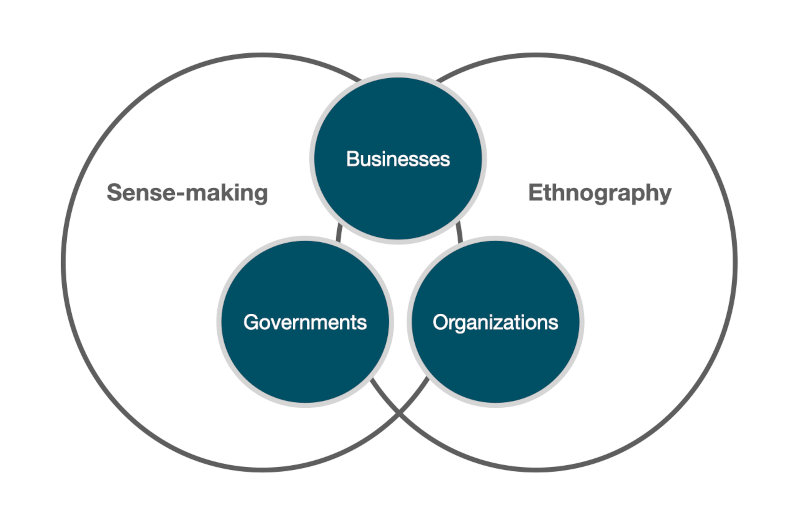
Sense-making
Sense-making can be defined as the process whereby individuals make sense of their contexts (i.e., in a given problem-solving arena at work, or in choices in navigating their family through a challenge, and the like). A core assumption of sense-making is that the process of moving through time involves discontinuities, particularly in terms of the individual’s understanding of their situation and their surroundings. As individuals encounter situations, they also encounter discontinuities, things to figure out, and they are compelled to develop strategies for overcoming them. A person’s strategies cover a wide range of possible outcomes including being at peace with the discontinuity. The process of overcoming discontinuities is a central feature of sense-making.
A person’s sense-making can be surfaced using various means as noted above (interviewing, written/keyed-in responses to sense-making questions, among others). While an individual’s sense-making can be quite idiosyncratic, most often people communicate and act together to form a collective sense of things. A collective sense of things can be surfaced as well, providing helpful information for those wanting to engage with support, provide a product or service to a group of people.
Sense-making is ongoing, so individuals simultaneously shape their choices and act in the situations they face. As they engage with their situation and observe the consequences of various actions they take, they learn and adapt. People extract cues from their contexts to help them decide what information is relevant and what explanations are acceptable. These cues provide points of reference for linking ideas to broader networks of meaning from which people develop a larger sense of what may be occurring. People do this naturally.
"Leaders of organizations are in . . . a double bind. If they only listen to what is around them, they will lose touch with the average person. If they spend too much time in the margins (where a lot of insight and innovations emerge, but also a lot of bunk) they will waste time . . . sense-making methodologies and ethnography, have the potential, with the right tools to bridge this gap."
A visual primer on principles of individual sense-making
The following diagrams can help readers make sense of an individual’s lived sense-making process. As a person lives, a sequence of events and experiences unfold with an untold number of visual, physical, aural, and other sensory inputs flowing into the person’s body and mind. Most events also involve the person’s choices and actions.
Events are perceived sequentially, which are represented graphically as the steps (yellow planks of differing size) in the first diagram. Each event is accompanied by a constant flow of mental and emotional processing. Most of this is subconscious since the conscious human mind can only attend to a small number of mental and sensory inputs at a time. Each event contains some kind of sense-making process the individual created. The white text below the yellow blocks represents various considerations held by the person. Further down into the darker depths of the diagram are more subtle or subconscious values and beliefs held by the person that are used to guide sense-making, decisions, and actions. As the individual “steps” into the next action, sense-making and volition is applied as to what to do and why. All this happens at the speed of living in the moments of time.
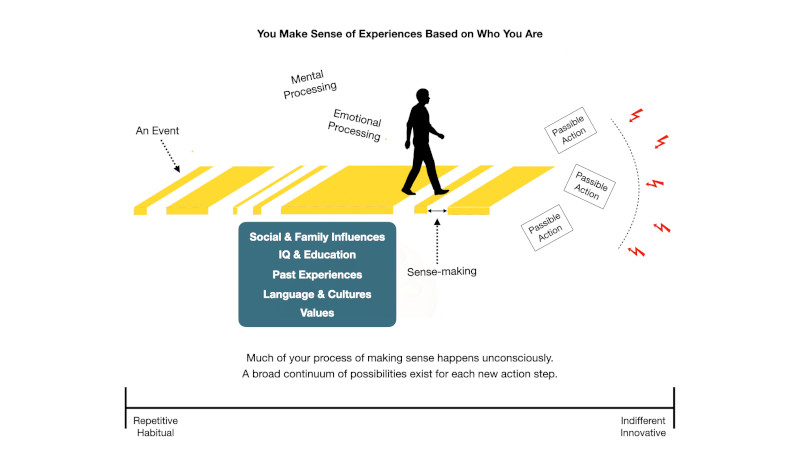
The second diagram focuses on the experiential and mental “space” between two steps or events. This space is a kind of compression of mostly subconscious deliberations about values, preferences, needs, and decisions of what to pay attention to and what to do next. These processes are collectively labeled as “Sense-making” in the space between events or steps.
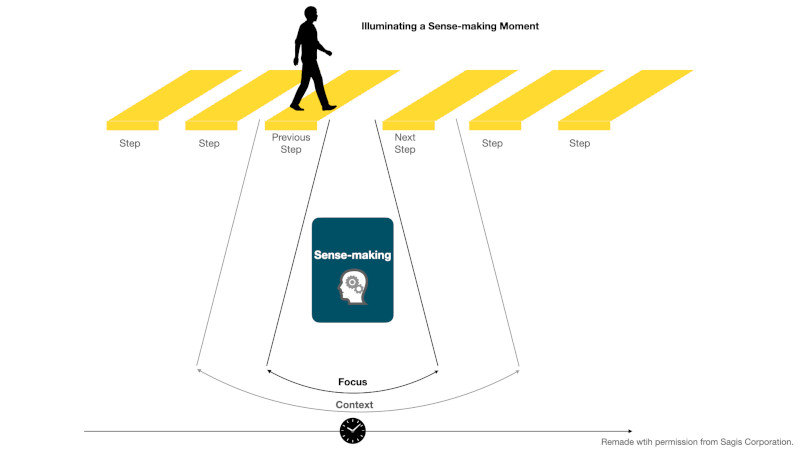
The third diagram shows the kinds of considerations a person might process in the moment between or during steps. These considerations are organized into general categories that were identified from Brenda Dervin’s research on sense-making. In the sense-making moment a person will quickly assess the Situation and relate it to Questions, Emotions, Intentions, and Wishes. It is useful to assume that individuals have general, if not explicit, goals and intentions across many events over time.
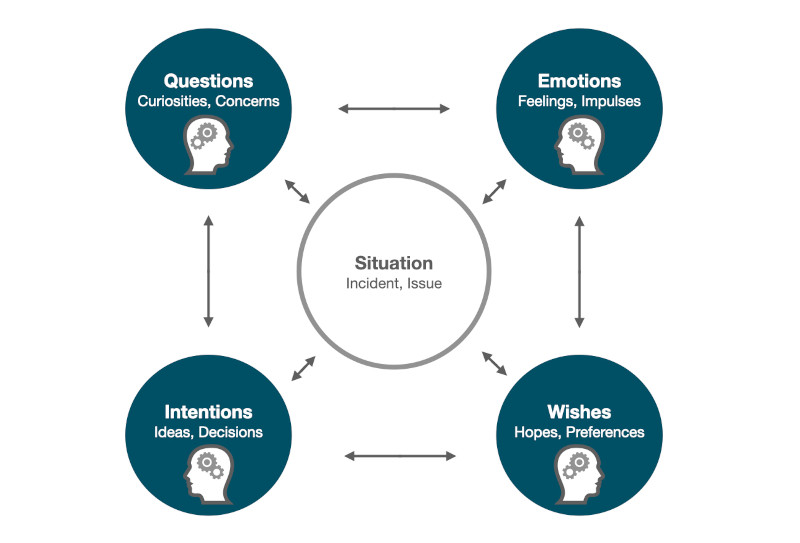
Sense-making Principles
Principle 1: Your experience is made up of actions (initiated by you, or by someone or something else that affects you) and your reflections on those actions
- Principle 1a: As you move through time, you are always “making sense” based on your background, previous experiences, core values, and beliefs.. This is personal, constant and pervasive – it happens at the speed of life.
- Principle 1b: You are the ‘author’ of how you make sense of your experience
- Principle 2a: When you articulate your experiences you are taking the embodied and unconscious and bringing it into the cognitive and conscious
- Principle 3a: Small differences in questions’ wording make big differences in what you say
- Principle 3b: The best articulation of your deep reflection occurs when the questions being asked are neutral. Neutral Questions: Are those that, 1) Concern movement, i.e., verbs instead of nouns, and 2) Allow you to name your world, i.e., use your own nouns, not the interviewers’ or the app’s nouns. We want to know how individuals see the world and relationships between elements. We do not want to give them expert vocabulary and ask them to fit their experience into our noun boxes.
- Experience moving through time
- See themselves in situations as they happen
- Have emotions at any given moment
- Seek to figure things out and have ways of proceeding to do so
- Make decisions, evaluate their situation, and have ideas
- Have hopes or wishes for outcomes
We have unconscious routines that we use to select and filter experiences. People tend to talk retrospectively in such a way as to gloss over important sensemaking they employed ‘in the moment’ to move. This is why using questions that elicit real time experience using present tense are best. For example, “Put yourself in your mindset when you are facing the situation. How are you feeling at this moment?” instead of, “What were you feeling then?”
The need for sensemaking tools or aids: Individuals often struggle to recall how they constructed meaning in the solving of challenges and problems. The assistance of an interviewer or a software tool such as software can help lead them through a structured remembering.
The value of using sensemaking tools
- The most useful data emerges most effectively when an individual can relive their sensemaking
- Individuals have the ability via dialogue with other individuals (or with a software tool) to bring the embodied and unconscious into the cognitive and conscious
Help provided like this can lead to well-elicited insights into the individual’s experiences and choices. This often leads to an individual gaining greater insight into their own lived experiences. Insights like these can be used to increase appreciation, expertise, or clarify important events and choices.
"As individuals encounter situations, they also encounter discontinuities, things to figure out, and they are compelled to develop strategies for overcoming them.
Sense-making is ongoing (and) occurs naturally. Organizations of all types gain clear benefits when they understand conceptually how sense-making occurs and when they find tools to surface sense-making."
Four different schools of sense-making
Some confusion may exist regarding applications in the field of sense-making practice. There are at least 4 distinct sense-making approaches. Each is generally identified with a key developer of the approach, with practitioners and advocates working in practical ways in the world. The approaches overlap often, and all have similar foundational philosophies, whether they be explicitly stated or not. Generally they have significant usefulness in their areas of focus. There are differences, though these are less substantial than their similarities.
The 4 approaches to sense-making, using their primary developers as the marker, are
- Brenda Dervin’s Sense-Making Methodology
- Karl Weick’s sensemaking in organizations
- David Snowden’s Cynefin framework
- Gary Klein’s “Data-Frame Theory”
- All of the theorists and practitioners using sense-making in one form or another find their roots, whether they are aware of it or not, with the founder of phenomenology, Edmund Husserl. Husserl, more than anyone prior to his time, focused on what he termed the science of human consciousness. While not coining the term sense-making (he wrote in German) he used the terms “making sense” frequently in describing the process whereby a person encounters a current situation and environment and makes sense of it through a consideration of their memories and how they understand the possibilities inherent in the situation. What is important about Husserl, and other phenomenologists such as Heidegger and Derrida, is their research demonstrating human capability to choose options in new ways. Hence, as humans make new sense in big and small ways, human consciousness expands over time
- Sense-making approaches shun the “naive realist transmission theory” of communication. This theory conveys in its simplest form, “If I communicate something to you, then it is your responsibility to understand what I said, and if you don’t it is your fault.” This theory assumes that communication is direct from one person to another. It fails to recognize the challenges of “background noise” for the “receiver” of the communication, and varying ways individuals encode messages and decode messages. Sense-making recognizes that effective communication requires becoming aware of how end-users/ receivers are decoding messages to ensure the interpretations are congruent with the intention of the senders. Agile Software Development is a methodology that includes frequent iterations with stakeholders to make sure that the intended design is being understood by the customer.
- Sense-making approaches intersect with the field of semiotics. This field, used heavily in scientific research, business and organizational marketing, and in electronic communication methodologies, concerns how meaning is created and communicated via visual symbols. Semiotics traces its roots to the mid-19th century and the work of Ferdinand de Saussure, who is sometimes referred to as the father of semiotics (and linguistics). Husserl found much of his inspiration in his development of phenomenology from de Saussure.
- Sense-making practitioners and theorists view the concepts and mental frameworks of the world as socially constructed and not given. Reality is not objective but contested and hence, the possibility exists that individuals or groups of individuals may make sense in innovative ways, and thus, construct new understandings of situations or what it means to be human. These innovations can, when more and more individuals adopt a new perspective, change societies and laws to reflect these new understandings.
- Sense-making practitioners and theorists also place value on attending to the emotions, intuitions, and preferences of individuals and the roles they play in how the individual makes sense of a given situation. Sense-making is understood to be a whole person activity and can include wishes, how one sees oneself, curiosities, associations, and feelings.
- Sense-making emerges in conversations and dialogues on different levels - internal, individual to individual, individual to group, group to group, and on a societal level. James R. Taylor and the Montreal School school of organizational communication is one example of an emphasis on communication as organizing. Taylor was a close colleague with Sense-Making Methodology’s Brenda Dervin.
Brenda Dervin’s Sense-Making Methodology
Brenda Dervin, Professor Emeritus at Ohio State University, developed a fully explicated methodology and practice (Sense-Making Methodology or SMM) for studying and engaging in sense-making. Dervin's approach has been designed to be useful in any context that involves communicating intrapersonally, interpersonally, or via mediated means. SMM consists of a set of philosophical assumptions, substantive propositions, methodological framings, and methods. It has been applied in myriad settings (e.g., corporate, government, military, libraries, information systems, media systems, web sites, public information campaigns, counseling services, and so on), at myriad levels (e.g., intrapersonal, interpersonal, small group, organizational, mass, national, global), and within myriad perspectives (e.g., constructivist, critical, cultural, feminist, postmodern, communitarian). Her approach significantly influenced Karl Weick, who, in turn, significantly influenced David Snowden.
Dervin’s microethnography, micro-interview, and micro time-line innovations have proven most effective in getting at the sense-making of individuals. Sagis Corporation uses Dervin’s approaches to get at the “deep smarts” of leaders and experts, particularly for organizations that seek to retain the intellectual capital of retiring leaders and to onboard new leaders.
Dervin shares with the other sense-making approaches attention to human beings in ways more holistic than traditional emphases have allowed. She also shares the common emphasis on humans making sense amid uncertainty, complexity, and chaos. She shares especially with Weick and Snowden their emphases on facilitating diverse voices to speak and be heard, their use of various philosophic inputs, and their emphases on narrative and storytelling. With Snowden, she shares an interest in inventing alternative systematic forms of communicative intervention (Snowden took this interest and created his proprietary software SenseMaker. Others have created additional systemic tools, e.g., Spryng).
Dervin often stated “There is no such thing as organization. There is only organizing.” The point in both cases is to move away from viewing reality as a collection of static, fixed entities (nouns) to viewing human systems as ever-changing entities. “It is about the ‘process of becoming’ rather than the ‘states of being.’” As mentioned above, this is the essence of James R. Taylor and colleagues’ work.
Karl Weick’s Sensemaking in organizations
Karl Weick is best known for his attention to organizational sense-making and his seminal work, Sensemaking in Organizations, along with his follow up writings. These continue to be a focus of study in many business schools.
His emphases:
- Activities and structures of organizations are determined in part by micro-momentary actions of their members.
- Action is based on a sequence in which individuals attend to cues in the environment, interpret the meaning of such cues, and then externalize these interpretations via concrete activities.
- Meaning is created when cues are linked with well-learned/or developing cognitive schema (these are the mental frameworks within each person that influences how an individual attends, perceives, and infers).
- People can verbalize their interpretations and the processes they use to generate them
- The role of stories in sense-making given that people think narratively rather than argumentatively or paradigmatically. Most models of organizations are based on argumentation rather than narration.
David Snowden’s Cynefin framework
David Snowden has written numerous articles and chapters for books on his approach to human sense-making.
As an organizational theorist and practitioner, his definition of sense-making,
“How do we make sense of the world so that we can act in it,”
shows his focus on the outcomes of one’s sense-making. This has led him to develop applications addressing the needs of organizations of all types. His theory acknowledges conditions of uncertainty or, in some cases, chaos, and in his consulting work he looks to identify coherent anchor points for action for the client.
He engages in what is sometimes termed complexity science. Complexity science is concerned with complex systems and problems that are dynamic, unpredictable and multi-dimensional, consisting of a collection of interconnected relationships and parts. Unlike traditional "cause and effect" or linear thinking, complexity science is characterized by nonlinearity.4 Snowden asserted that anthro-complexity needs to be introduced more fully into complexity science.
Reminiscent of the field of personology and particularly the work of Dan P. McAdams, Snowden identifies 3 ways humans are different from other animals:
- Intentionality: Humans make deliberate choices, engage in abstraction, goal setting, and so on. Some intentionality can be found in other sentient life forms but not of the frequency and complexity of humans.
- Intelligence: Humans can alter the world to suit human purpose and use reflection and abstraction to do so.
- Identity: Identity, in humans, is fluid. We move between roles depending on our context. One can be a daughter, a friend, a colleague, a consultant, a student… and yet have a stable core of self that navigates between these roles.
David Snowden's approach to sense-making shares much in common with that of Weick. Both focus primarily on organizational decision making, strategy development, and handling complex situations. Both emphasize the value of narrative as a procedural response to complexity. And they, along with Dervin, recognize context and situation as the focal point for problem solving.
Gary Klein and his “Data-Frame Theory”
Gary Klein is an American psychologist well-known for Naturalistic Decision Making. He has worked extensively as a consultant serving government and corporate clients. He specializes in “macrocognition,” a term he coined to indicate his community of researchers’ interest in all kinds of cognitive functions. One of his main areas of focus is Data-Frame Theory, which describes the relationship between data, or signals of events, and cognitive frames, or explanatory structures that account for the data and guide the search for more data. A main assertion of this theory is that sensemaking is the process of fitting data into a frame and fitting a frame around the data.
In his own words, “Sensemaking is the deliberate effort to understand events. It serves a variety of functions, such as explaining anomalies, anticipating difficulties, detecting problems, guiding information search, and taking effective action. We present a data-frame theory of the process of sensemaking in natural settings. The theory contains a number of assertions. (The following is summarized from Klein’s article, (PsycInfo Database Record (c) 2020 APA, all rights reserved)
- The theory posits that the interaction between the data and the frame is a central feature of sensemaking. The data, along with the goals, expertise, and stance of the sensemaker, combine to generate a relevant frame. The frame subsequently shapes which data from the environment will be recognized as pertinent, how the data will be interpreted, and what role they will play when incorporated into the evolving frame.
- Observations in several domains suggest that people select frames based on a small number of anchors--highly salient data elements.
- His research is consistent with prior work showing that expert-novice differences in sensemaking performance are not due to superior reasoning on the part of the expert or mastery of advanced reasoning strategies, but rather to the quality of the frame that is brought to bear.
- He suggests that people more often construct Just In Time mental models from available knowledge than draw on comprehensive mental models.
- The data-frame account of sensemaking is different from an information-processing description of generating inferences on data elements. People do not merely churn out inferences. They are actively trying to experience a match, however fleeting, between data and frame.
Other less formal ventures into sense-making
In recent years a growing number of people are exploring how to make better sense of life and experiences as individuals as well as venturing into how to help groups and organizations make better collective sense of what people think, know or are doing. Some of these groups are at www.rebelwisdom.com. Rebelwisdom.com collects practices and ideas to help people make sense of their lives and, in particular, the online mass of information and ideas. Various contributors share their practices, experience, and ideas or philosophies.
Some of these ventures draw from, James Surowiecki, The Wisdom of Crowds: Why the Many Are Smarter Than the Few and How Collective Wisdom Shapes Business, Economies, Societies and Nations (2004), which contributes specific ideas and practices that help groups of people make sense together. This and similar ideas are promoted or discussed at websites.5
Conclusion
Humans have always made sense as they navigate challenges inherent in living. This overview of business ethnography and sense-making approaches and applications points to the burgeoning of the fields that recognize this reality. Organizations of all types gain clear benefits when they understand conceptually how sense-making occurs and when they find tools to surface sense-making. This data, in the crucible of keen minds, can bring about all kinds of improvements in how organizations serve their stakeholders, and bridge the gaps to where insight and innovation occur.
What is Active Sensemaking?
Active Sensemaking (AS) practically applies sense-making in complex human situations and systems.
Active Sensemaking is a powerful methodology that makes it possible to capture the unique individual voices within an organization while at the same time uncovering larger patterns of meaning generated by those individuals.
By revealing significant patterns around challenging issues while, at the same time, retaining the individual stories behind those patterns, Active Sensemaking provides an invaluable tool.
Human systems are the context for almost everything relevant to personal living, community, business, and government. AS respects and applies aspects of sensemaking from the four primary developers of approaches to sensemaking. Brenda Dervin’s Sense-making Methodology helps AS because it clarifies the importance of individual sensemaking and how people can communicate their lived experiences with context and meaning through focused narratives or stories of their sensemaking. Karl Weik’s organizational sensemaking perspectives contribute to AS to help discover collective sensemaking and recognize the processes people go through to organize together. David Snowden’s approach to sensemaking with Cynefin helps AS practitioners deal with the complex dynamics of human systems, particularly to identify relevant patterns in the system that emerge from the complex interactions of people and environmental forces and approaches to influence those patterns. Gary Klien’s “Data-Frame theory” points AS practitioners to pay attention to the ways people use the data or evidence in their experience to fit to their current or emerging “frames” for making sense of what they are experiencing or doing.
Complexity in human systems and situations is a critical feature and context for AS practice. Making sense of a complex situation by humans is a multifaceted process in which AS seeks to collect experiences through a unique kind of carefully designed and specifically contextualized questionnaire.
By their nature as complex adaptive systems, nothing is static and nothing can be predicted. But individuals’ experiences and narratives of those experiences are able to provide snapshots of what happened with and around them in a situation. AS works to maximize the possibility of gaining relevant insights into situational patterns based on many people’s many “snapshots” as stories with context and meaning. These insights can be used to influence patterns in the situation or system. That is why it is called Active Sensemaking. AS provides an approach to leverage the natural ways that humans navigate and influence their world, reflecting how people have always made sense of their lives from the dawn of history.

